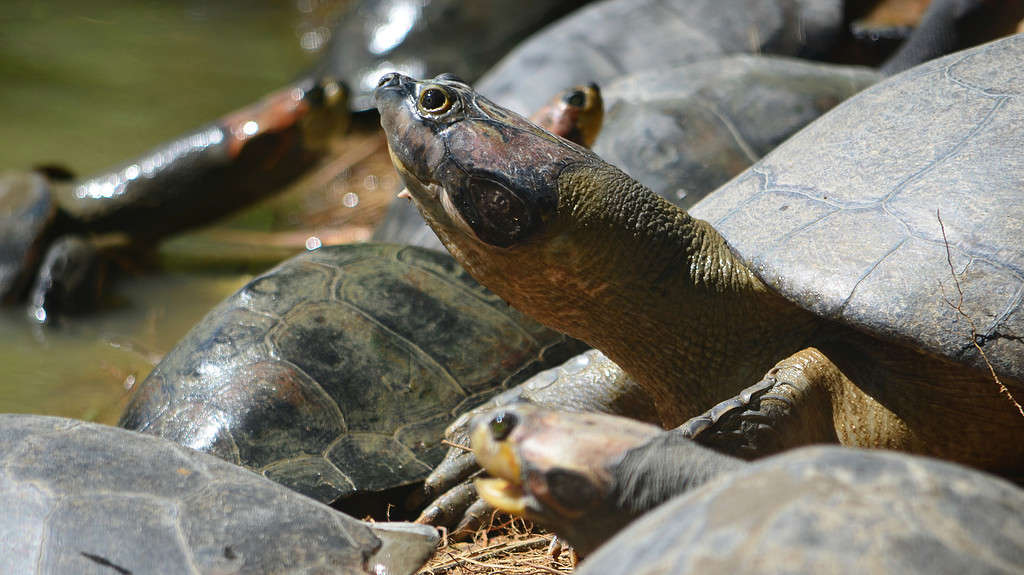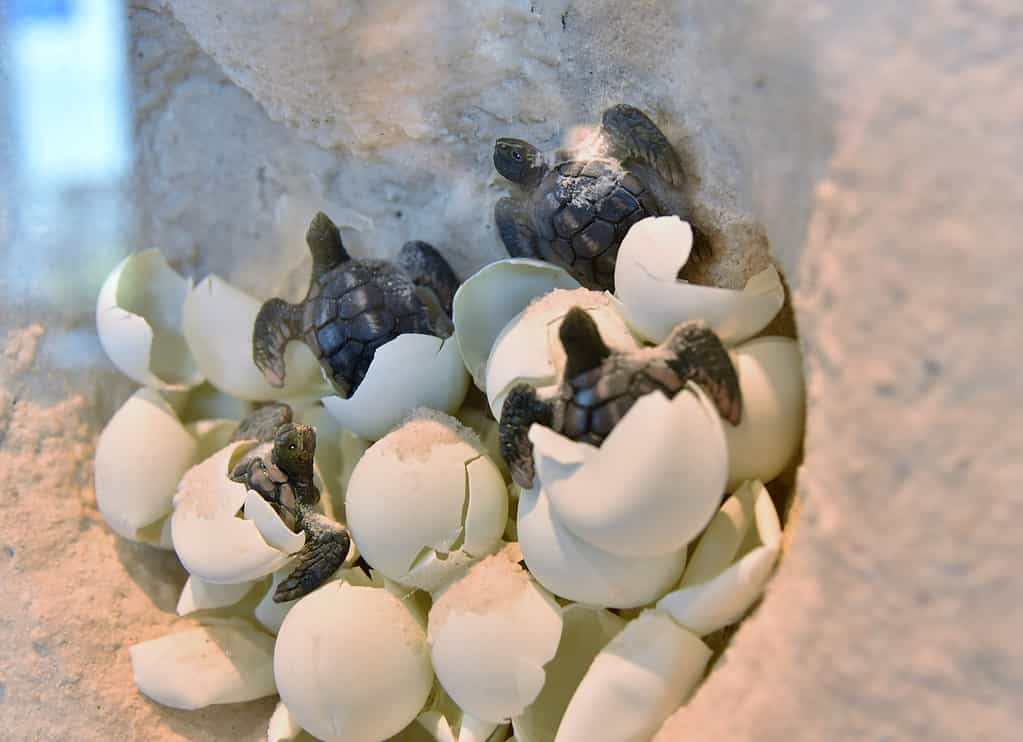In the past decade, scientists have discovered that turtles have a much wider range of communication abilities than previously thought. Far from a silent, solitary reptile, many species of turtles appear to produce complex and social intra-specific communication. So, how do turtles communicate?
Read on to find out!
How Do Turtles Communicate: Acoustic Signals
Until recently, biologists believed turtles were non-vocal, primarily animals. They lack vocal cords and can thus not produce vocalizations in the strict sense of the word. They can, however, produce a number of other acoustic signals.
A study published in 2022 revealed that at least 50 species of turtles can make a range of acoustic signals previously unknown to researchers. These sounds include hissing, grunting, gurgling, bellowing, clicking, squeaking, croaking, snorting, and even purring. Turtles produce these sounds through other mechanisms. For example, they can produce a hissing noise by pulling their head back into their shell and forcefully expelling air from their lungs. This automatic noise happens when frightened or threatened turtles rapidly retract into their shell. Other sounds may indicate excitement. When they eat, some turtles will produce little squeaks and grunts.
Underwater Acoustic Communication
A 2013 study found that some freshwater species of turtles can communicate acoustically underwater. Researchers discovered that the Western Australian longneck turtle (Chelodina colliei) can produce complex, percussive calls, typically in the frequency range below 1,000 Hertz. The researchers found that similar sounds are made by female South American river turtles (Podocnemis expansa) during migration to nesting areas. These sounds may be related to information sharing between nesting females.
In a 2009 study on the southwestern snake-necked turtle (Chelodina oblonga), researchers recorded 17 types of vocalizations, including squawks, hoots, short chirps, long chirps, wails, growls, and percussive drumming. The researchers proposed that the range of acoustic sounds produced underwater by Chelodina oblonga may compensate for the poor-visibility environments they tend to live in. Thus, the sounds may communicate with other turtles of their species over distances beyond their visual range and likely include courtship advertising.

Over the past decade, researchers have recorded and documented a range of acoustic sounds produced by turtles, some of which likely serve social communication purposes.
©marktucan/iStock via Getty Images
Acoustic Communication During Group Nesting
A study published in 2014 researched the acoustic communication of the social Amazonian river turtle (Podocnemis expansa) during group nesting. This study, carried out from 2009-2011, recorded six distinct types of sounds made by female turtles during the nesting period. These sounds were categorized into the following five categories:
- Migration to nest sites
- Aggregation at the nesting beaches
- Nesting at night
- Waiting in the water after nesting or without nesting
- Waiting for the arrival of hatchlings
The researchers found that these sounds likely play an important and unique role in synchronizing activities of social female turtles during the nesting season to reduce predation, increase hatchling survival, and exchange information between nesting females.
Acoustic Communication Between Hatchlings
Scientists have been studying the sounds hatchlings make while still in their eggs for over a decade to determine if acoustic communication is occurring. Many species of reptile hatchlings will synchronize hatching events, although scientists are still trying to understand the mechanism behind the synchronization. Researchers are trying to ascertain if sounds made by hatchlings aid in synchronized hatching in both semi-aquatic and sea turtles.
A study published in 2019 recorded sounds of hatchlings in many egg clutches of the Ouachita map turtles (Graptemys ouachitensis). The researchers recorded four types of repeated sounds made by hatchlings up to 14 days before emergence from the eggs. They found that a type I sound, characterized by a distinct clicking, began 11-14 days before emergence. The other three types of sounds began less than five days before hatching and indicated hatchling movement. The type I clicking sound increased in frequency as the hatchlings reached the emergence date. Researchers propose it’s possible the type I clicking noise served as a means of communication across the clutch and aided in synchronized hatching movements and emergence.

Some species of hatchling turtles may communicate acoustically to aid in synchronized hatching.
©Florida Chuck/iStock via Getty Images
Acoustic Communication of Sea Turtles
Until recently, marine biologists believed non-hatchling marine turtles to be silent or nearly silent animals. However, recent studies are proving sea turtles’ ability to perceive sound and produce vocalizations. A study published in 2022 documented ten different sounds produced by 11 free-ranging juvenile green sea turtles (Chelonia mydas). These sounds were arranged into the following categories: pulses, low-amplitude calls (LAC), frequency-modulated sounds, and squeaks. The researchers found that the turtles produced these sounds within the hearing range of other sea turtles (approximately 200-740 Hertz), suggesting the ability for intra-species communication. The squeaks appeared to have unique signatures for individuals, adding to the idea that at least some of the sounds serve as communication.

In a study published in 2022, researchers proved that green sea turtles produce a range of vocalizations that may function as social communication.
©Shane Myers Photography/Shutterstock.com
How Do Turtles Communicate: Visual and Tactile Communication
Turtles can also use visual communication to signal to other members of their species. During courtships, females often blink repeatedly to signal interest, and males bob their heads up and down. The male will also squirt water at the female during courtship. Some turtles, such as the sliders (Trachemys), flutter their front claws and open their jaws to communicate aggression or defensiveness.
The photo featured at the top of this post is © Dennis Diehl/Shutterstock.com
Thank you for reading! Have some feedback for us? Contact the AZ Animals editorial team.







